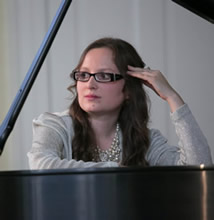This preview has been provided by Carolina Pro Musica.
Carolina Pro Musica plays Music of the Masters: German Baroque Music on February 13th at 8:00 pm at Belmont Abbey Basilica and on February 18th at 8:00 pm at St. Martin’s Episcopal Church, Charlotte. Their program focuses on three of the great composers of the late Baroque: Johann Sebastian Bach, Georg Frederich Handel and Georg Philipp Telemann. The ensemble, consisting of director and harpsichordist Karen Jacob, soprano Rebecca Saunders, flutist/recorder player Edward Ferrell and viola da gamba player Holly Maurer, presents sonatas, solos, and arias from cantatas and operas on period instruments.
J.S. Bach produced a vast number of cantatas over five annual cycles during his tenure as Cantor of St. Thomasschule and Musical Director of Leipzig. “Hochster, was ich habe” from Cantata 39 uses the theme of simple faith. The text can best be understood as part of the greater theme of the Cantata, that if we truly love God, we must also love our neighbor. In addition to this aria set for soprano, obbligato recorder and basso continuo, the group will perform an excerpt from Easter Oratorio, “Seele, deine spezereien” for soprano, obbligato flute and basso continuo. The oratorio, based on a secular cantata, was revised several times between 1725 and 1740.
Handel, born in Halle, Germany, traveled to Italy as a young man to study the Italian style. After a brief return to Germany he settled in London where he composed first opera, and then when society became more conservative, oratorios including his most famous, Messiah. Saunders will sing two works of Handel’s, a German song, “Flammende Rose” and the aria” O had I Jubal’s Lyre” from the oratorio Joshua. Premiered in March 1748 the oratorio is one of a series based on military themes and this aria includes passages of vocal fireworks indeed.
G. P. Telemann, widely regarded as Germany’s leading composer during his lifetime, is seen today as a musician with the ability to interpret and incorporate a wide range of styles into his music. The aria “Piu del fiume da diletto” from his opera Aesopus clearly reflects the Italian style while the Trio Sonata in F, published in 1740 in Essercizii Musici, expertly weaves the lines of the recorder, viola da gamba and continuo in an exuberant expression of chamber music. Contrasting the happy trio, the Sonata in f minor uses chromaticism to give the recorder solo an expressive poignancy.
Don’t miss these and other works by these great Masters of Baroque Music as interpreted by Carolina Pro Musica.













